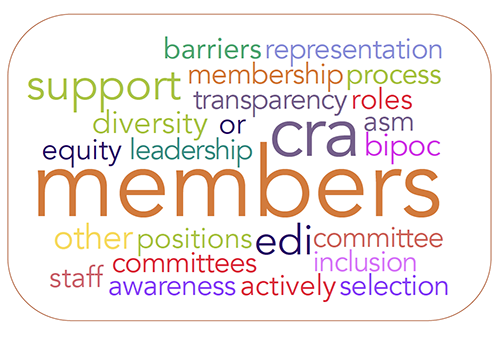Fall 2021 (Volume 31, Number 3)
Survey Results:
Equity, Diversity, and Inclusion
Download PDF
With an ever-evolving and diverse population,
equity, diversity, and inclusion (EDI) initiatives
are more important than ever before. Addressing
gaps in equity, diversity and inclusion is long overdue in
many parts of our society as we confront injustices past
and present. This past year, the Canadian Rheumatology
Association (CRA) created an EDI Task Force with the aim
to ensure that the CRA is an inclusive, diverse association
reflective of the Canadian population and that issues surrounding
health equity are addressed and mitigated.
For this issue’s Joint Count survey, the CRA asked its
membership for their perspectives on EDI as it relates to
the association and the Canadian rheumatology landscape.
A total of 75 responses (out of a possible 578) were received,
equating to a response rate of approximately 13%.
In the first part of the survey, members were asked to
rate the CRA on various aspects of equity, diversity and inclusion.
When asked to rate the following “People from all
backgrounds and with a range of identities have equitable
opportunities to advance their skills and engagement at
the CRA”, only 43% were in complete agreement (see Chart
1 for a complete breakdown). For a sample of questions on
diversity and inclusion, refer to Charts 2 and 3.
When asked “What does equity, diversity and/or inclusion
in the context of the CRA mean to you?” one member
wrote, “I believe the focus should be on the composition of
the CRA. Who are the members? Do they reflect the composition
of Canadian society? What about the CRA staff,
board and operational committee chairs? Do we run our
meetings and events in such a way to promote full participation?
Does the HR committee take specific actions in recruitment
considering EDI? Do we use inclusive language
in CRA communications?”
Other comments highlighted “actively promoting inclusive
practices such as Indigenous sensitivity training”;
“avoiding only Ontario and Quebec physicians/scientists
in all committees”; and “not only including people of traditionally
marginalized backgrounds (i.e. ethnicity, gender,
language, physical disability) in things like committees or
as speakers at events, but rather actively seeking them out
to participate. Sometimes it is difficult for marginalized
folks to feel comfortable stepping up on their own, so the
reaching out step is key as well.”
CHART 1:
Survey Results: “People from all backgrounds and
with a range of identities have equitable opportunities
to advance their skills and engagement at the CRA”

CHART 2:
Survey Results: “The CRA invests time and energy into
building diverse teams.”

CHART 3:
Survey Results: “I feel my unique background and
identity (namely my differences) are valued at the
CRA.”

What actions do you feel the CRA should
take with respect to increasing equity,
diversity and inclusion for all members
and staff?
With regard to actions that the CRA should
take, being transparent was mentioned in
multiple comments. A couple of the comments
remarked that the CRA is already quite diverse.
Some of the specific actions
recommended included:
- Increase transparency and openness to
members on the selection process for
leadership
- Proactively include varied backgrounds in
leadership positions and on committees (in
terms of gender, culture, etc.)
- Honour those who are striving to make changes
- Continue to support diversity in training opportunities
- Provide seminars to all members, on a regional basis
- Build on relations with First Nations communities
- Offer scholarships or direct active recruitment of summer studentships to marginalized
groups (i.e. BIPOC youth [high school/undergrad], LGBTQS2 youth, and those with
physical disabilities or hearing impairments), in addition to traditional groups
- Attempt to attract and train a more diverse pool of new rheumatologists to reflect their
representation in society
- Have modules or workshops given by members from marginalized groups to help increase
others' awareness and provide strategies for inclusion in their clinics or practice
- Build awareness and identify potential barriers and gaps in implementation
- Ensure language is inclusive of all
- Acknowledge the importance of EDI in the CRA mission statement and include EDI
principles in its values
 |
| 



